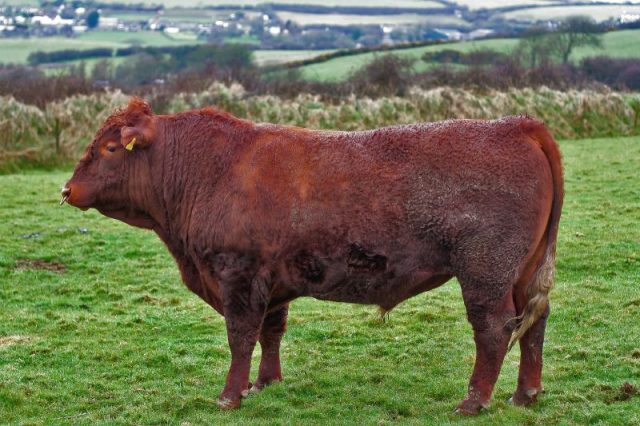Type the name of the breed you're looking for below
[wpdreams_ajaxsearchlite] Don't see the breed your're looking for? Click here and let us know!
North Devon cattle
| Place of Origin | Great Britain |
| Origin | The native home of the Devon is in southwest England, primarily in the counties of Devon, Somerset, Cornwall, and Dorset. The Devon is one of several modern breeds derived from the traditional red cattle of southern England, together with the Hereford, Sussex, Lincoln Red and Red Poll. The early improvers of the Devon breed were Francis Quartly of Great Champson, Molland, North Devon, and his elder brothers Rev. William (of West Molland Barton) and Henry (d.1840), the eldest, who took over William's herd and lease in 1816. Francis had been left the lease of Champson with its herd by his father James (d.1793) and commenced his work in improving the breed the year after his father's death. At that time during the Napoleonic Wars most of the farmers of Devon were taking advantage of the high prices offered by butchers for cattle, and the best bloodlines of the old herds were almost lost. Francis Quartly had the foresight to refuse to sell his best specimens and furthermore determined on the risky and expensive strategy of outbidding the butchers to acquire for himself what he judged to be the best representatives of the remnant of the old breed. Thus was founded the Champson herd. Francis and William died unmarried but Henry's eldest son James succeeded him at West Molland and his youngest son John succeeded his uncle Francis at Champson. Both became highly distinguished breeders of Devons. Also instrumental in the founding of the new breed were John Tanner Davy (d.1852) of nearby Rose Ash and his brother William (d.1840), of Flitton Barton. Colonel John Tanner Davy, son of John Tanner Davy, founded the Devon herdbook in 1850. In 1884, the Devon Cattle Breeders' Society was founded and took over the herdbook. Today the Dart family of Great Champson, Molland, long established in that parish, continues to breed the descendants of the Quartly herd in their original home. The herd was founded by George Dart in 1947 with animals purchased from the Molland herd, and is carried on today by the brothers William and Henry Dart. In the United States; In 1623 the ship Charity brought a consignment of red cattle (one bull and three heifers) from Devon to Edward Winslow, the agent for Plymouth Colony – these may have been of North Devon type. Although the Devon was originally a horned breed, American stockmen have developed a polled strain of purebred Devons. It traces back to the bull Missouri 9097, a hornless individual born in 1915 in the Devon herd owned by Case and Elling in Concordia, Missouri. The Devon was previously classified as a dual-purpose breed (dairy & beef). Over the past half century, however, the breed has developed as a beef-type breed. The rate of maturity has been accelerated, and a common criticism of light hindquarters and sickle hocks have been reduced to a minimum. Devons have become longer, taller, and trimmer, but not to such extremes as in some other breeds. The traditional multi-purpose animals still exist in the United States and are now known as the American Milking Devon, though they are very rare. They are registered with the American Milking Devon Cattle Association. In Australia; Devons were popular for use in bullock teams for hauling cedar and other logs from the forests, which was pit sawn and then transported by bullock drawn wagons and timber junkers to towns and seaports for cabinet making or export. These cattle were among the earliest breeds in Australia and Devons were noted for their docility, early maturing, hardiness and strength which were important attributes to have in a team. |
| Purpose | The functional characteristics of the Devon make them a valuable genetic tool for the commercial beef industry. |
| Appearance | Devon cattle are red in colour, varying in shade from a rich deep red to a light red or chestnut colour. A bright ruby red colour is preferred and accounts for their nickname, the "Red Ruby". The hair is of medium thickness and is often long and curly during the winter, but short and sleek in summer. The switch of the tail is creamy white. |
| Horns | Medium size horns or polled (hornless) depending on the strain. |
| Cows Average Weight | 430 kg (948 lbs.) - 590 kg (1301 lbs.) |
| Bulls Average Weight | 770 kg (1698 lbs.) - 1,000 kg (2205 lbs.) |
| Other Considerations | In recent years however, the breed has fallen out of favour, as more rapidly growing continental breeds were in demand by both the farmer and butcher because of their speed of maturity and the quantity of higher-value cuts they produce. However, that meat has always been of a lower-eating quality than that of the slower-maturing grass-fed traditional breeds. |



